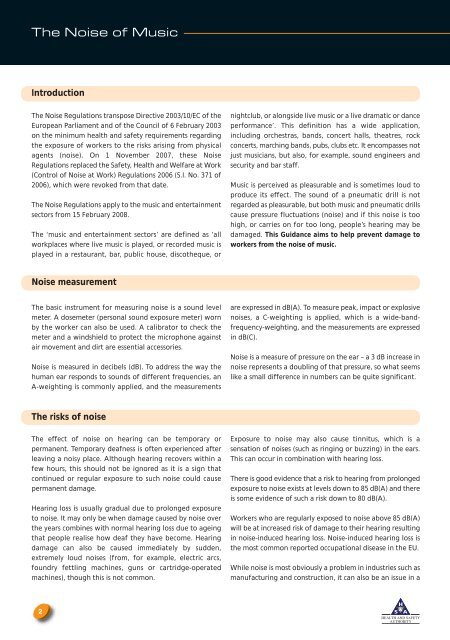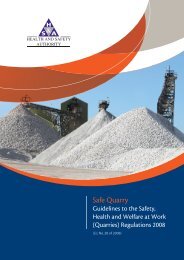The Noise of Music.pdf - Health and Safety Authority
The Noise of Music.pdf - Health and Safety Authority
The Noise of Music.pdf - Health and Safety Authority
You also want an ePaper? Increase the reach of your titles
YUMPU automatically turns print PDFs into web optimized ePapers that Google loves.
<strong>The</strong> <strong>Noise</strong> <strong>of</strong> <strong>Music</strong><br />
Introduction<br />
<strong>The</strong> <strong>Noise</strong> Regulations transpose Directive 2003/10/EC <strong>of</strong> the<br />
European Parliament <strong>and</strong> <strong>of</strong> the Council <strong>of</strong> 6 February 2003<br />
on the minimum health <strong>and</strong> safety requirements regarding<br />
the exposure <strong>of</strong> workers to the risks arising from physical<br />
agents (noise). On 1 November 2007, these <strong>Noise</strong><br />
Regulations replaced the <strong>Safety</strong>, <strong>Health</strong> <strong>and</strong> Welfare at Work<br />
(Control <strong>of</strong> <strong>Noise</strong> at Work) Regulations 2006 (S.I. No. 371 <strong>of</strong><br />
2006), which were revoked from that date.<br />
<strong>The</strong> <strong>Noise</strong> Regulations apply to the music <strong>and</strong> entertainment<br />
sectors from 15 February 2008.<br />
<strong>The</strong> ‘music <strong>and</strong> entertainment sectors’ are defined as ‘all<br />
workplaces where live music is played, or recorded music is<br />
played in a restaurant, bar, public house, discotheque, or<br />
nightclub, or alongside live music or a live dramatic or dance<br />
performance’. This definition has a wide application,<br />
including orchestras, b<strong>and</strong>s, concert halls, theatres, rock<br />
concerts, marching b<strong>and</strong>s, pubs, clubs etc. It encompasses not<br />
just musicians, but also, for example, sound engineers <strong>and</strong><br />
security <strong>and</strong> bar staff.<br />
<strong>Music</strong> is perceived as pleasurable <strong>and</strong> is sometimes loud to<br />
produce its effect. <strong>The</strong> sound <strong>of</strong> a pneumatic drill is not<br />
regarded as pleasurable, but both music <strong>and</strong> pneumatic drills<br />
cause pressure fluctuations (noise) <strong>and</strong> if this noise is too<br />
high, or carries on for too long, people’s hearing may be<br />
damaged. This Guidance aims to help prevent damage to<br />
workers from the noise <strong>of</strong> music.<br />
<strong>Noise</strong> measurement<br />
<strong>The</strong> basic instrument for measuring noise is a sound level<br />
meter. A dosemeter (personal sound exposure meter) worn<br />
by the worker can also be used. A calibrator to check the<br />
meter <strong>and</strong> a windshield to protect the microphone against<br />
air movement <strong>and</strong> dirt are essential accessories.<br />
<strong>Noise</strong> is measured in decibels (dB). To address the way the<br />
human ear responds to sounds <strong>of</strong> different frequencies, an<br />
A-weighting is commonly applied, <strong>and</strong> the measurements<br />
are expressed in dB(A). To measure peak, impact or explosive<br />
noises, a C-weighting is applied, which is a wide-b<strong>and</strong>frequency-weighting,<br />
<strong>and</strong> the measurements are expressed<br />
in dB(C).<br />
<strong>Noise</strong> is a measure <strong>of</strong> pressure on the ear – a 3 dB increase in<br />
noise represents a doubling <strong>of</strong> that pressure, so what seems<br />
like a small difference in numbers can be quite significant.<br />
<strong>The</strong> risks <strong>of</strong> noise<br />
<strong>The</strong> effect <strong>of</strong> noise on hearing can be temporary or<br />
permanent. Temporary deafness is <strong>of</strong>ten experienced after<br />
leaving a noisy place. Although hearing recovers within a<br />
few hours, this should not be ignored as it is a sign that<br />
continued or regular exposure to such noise could cause<br />
permanent damage.<br />
Hearing loss is usually gradual due to prolonged exposure<br />
to noise. It may only be when damage caused by noise over<br />
the years combines with normal hearing loss due to ageing<br />
that people realise how deaf they have become. Hearing<br />
damage can also be caused immediately by sudden,<br />
extremely loud noises (from, for example, electric arcs,<br />
foundry fettling machines, guns or cartridge-operated<br />
machines), though this is not common.<br />
Exposure to noise may also cause tinnitus, which is a<br />
sensation <strong>of</strong> noises (such as ringing or buzzing) in the ears.<br />
This can occur in combination with hearing loss.<br />
<strong>The</strong>re is good evidence that a risk to hearing from prolonged<br />
exposure to noise exists at levels down to 85 dB(A) <strong>and</strong> there<br />
is some evidence <strong>of</strong> such a risk down to 80 dB(A).<br />
Workers who are regularly exposed to noise above 85 dB(A)<br />
will be at increased risk <strong>of</strong> damage to their hearing resulting<br />
in noise-induced hearing loss. <strong>Noise</strong>-induced hearing loss is<br />
the most common reported occupational disease in the EU.<br />
While noise is most obviously a problem in industries such as<br />
manufacturing <strong>and</strong> construction, it can also be an issue in a<br />
2

















